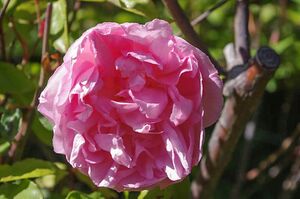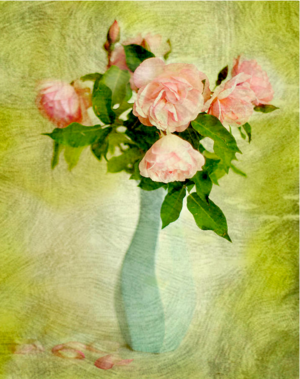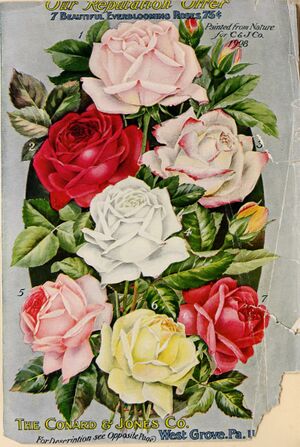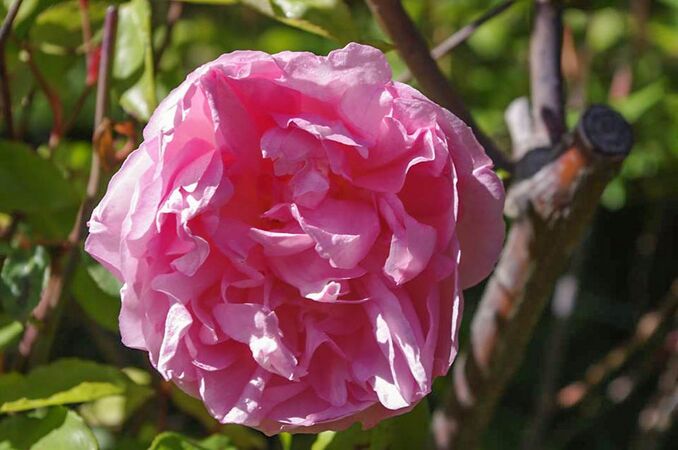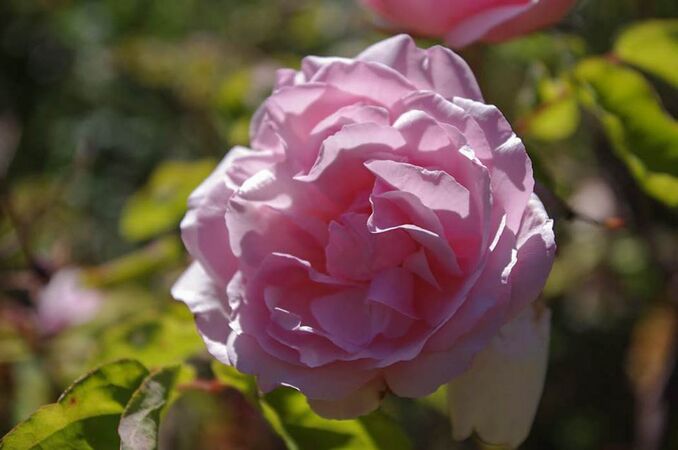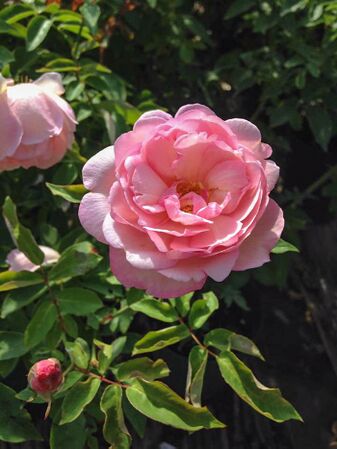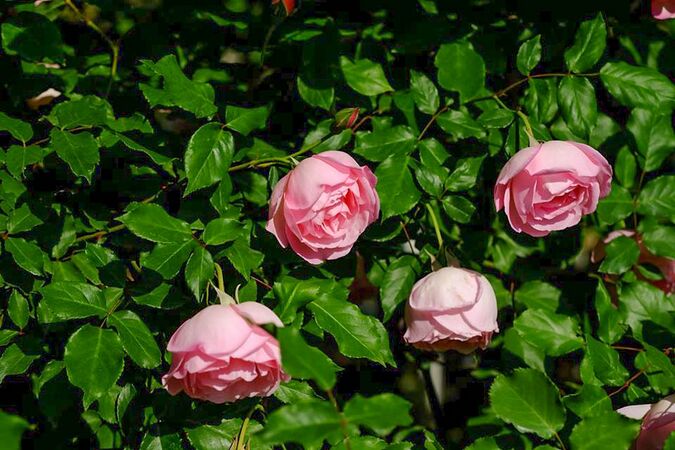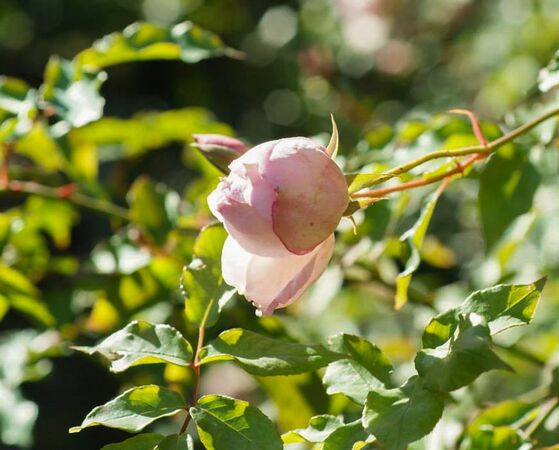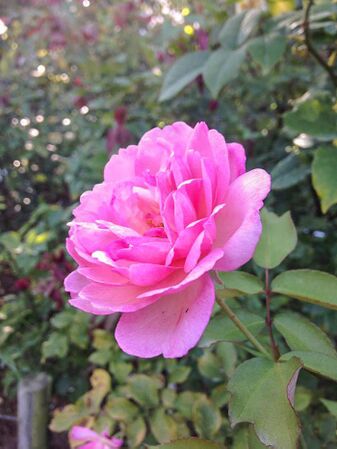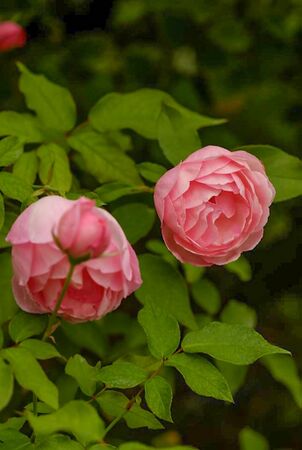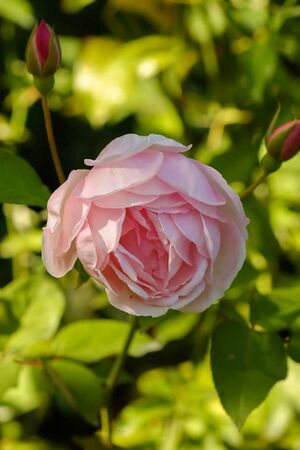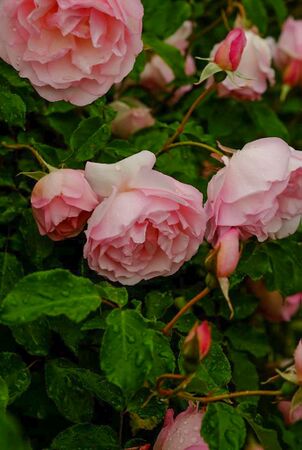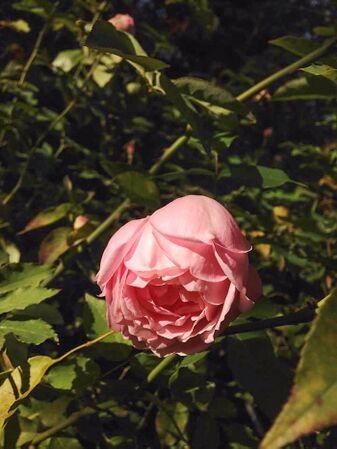Duchesse de Brabant
Teerose, 1857 ? - Züchter/breeder/obtenteur Pierre Bernède ?, Frankreich/Fance.
Eltern/parentage/parents: unbekannt/ unknown/ inconnus.
Synonyme/synonyms/synonymes: 'Comtesse de Labarthe' nein!, 'Comtesse de Labarathe' nein!, 'Countess Bertha', 'Shell', 'The Shell Rose, Teerose'.
Allgemeines • Preface • Remarques
Der Name dieser Rose mit seinen Synonymen ist nicht einfach zu erklären. Sie taucht 1872 in den USA auf, wird aber von 'Comtesse de Labarathe' in der Farbe unterschieden[1]. Die Farbbeschreibung wird ab 1874 präzisiert: Rosy-blush, shaded amber, ends of petals fringed (errötendes Rosa, bersteinfarben schattiert, Petalenränder gefranst)[2]. Diese Beschreibung findet man in den USA bis 1911[3]. Aber bereits vorher werden beide Rosen miteinander verwechselt, bis sie nur noch als 'Duchesse de Brabant' verbreitet wird.
In Europa findet man keine Rosengärtnerei, die eine 'Duchesse de Brabant' anbietet. Erst 1878 wird der Name im Journal des Roses erwähnt[4], und 1882 wird sie als synonym zu 'Comtesse de Labarathe' erklärt[5], also 25 Jahre nach der Züchtung - und in solch langer Zeit kann viel durcheinander gehen.
Aufgrund der deutlich unterschiedlichen Farbbeschreibung, führen wir 'Duchesse de Brabant' hier als eigenständige Rose.
Die Dynastie der de Brabants war in Europa weit verbreitet. Zur Zeit der Züchtung der Rose trugen allerdings nur noch die Könige von Belgien diesen Titel. Die Geehrte sollte demnach Marie Henriette Anne de Habsbourg-Lorraine[6] (* 23.08.1836, ✝ 19.09.1902) sein, Archiduchesse d’Autriche, geboren in Pest, Ungarn. Durch eine politisch arrangierte Hochzeit mit dem Duc de Brabant, dem späteren König Léopold II von Belgien, erhielt sie ihren Titel und wurde die zweite Königin von Belgien.
In den USA wurde die Rose berühmt, da Präsident Theodore Roosevelt[7] sie gern im Knopfloch trug.
The name of this rose with its synonyms is difficult to explain. It appeared in 1872 in the US but is different from 'Comtesse de Labarathe' regarding colour[1].
Following colour description dates from 1874: “Rosy-blush, shaded amber, ends of petals fringed [2]. one can find this description in the US until 1911[3]. But even before then the two roses were confused until commercialised only under the sole name of 'Duchesse de Brabant'. In Europe, not a single nursery offered the rose. It was first mentioned in 1878 in the Journal[4], and 1882 declared with a synonym as 'Comtesse de Labarathe'[5], in other words 25 years later – in such a long time span a lot of things can go wrong! On the base of the clearly different colour description, we shall register the rose here as 'Duchesse de Brabant'. The Brabant Dynasty was largely distributed in Europe. At the time of the creation of the rose only the Kings of Belgium carried this name. The rose was probably dedicated to Marie Henriette Anne de Habsbourg-Lorraine[6] (* 23.08.1836, ✝ 19.09.1902), Archi-Duchess of Austria, born in Pest, Hungary. Through a politically arranged mariage with the Duke of Brabant (who later became King Léopold II of Belgium) she received her Duchess title before becoming the second Queen of Belgium.
The rose became famous in the US as President Theodore Roosevelt used to carry the rose during public appearances[7].
Blüten • Blooms • Fleurs
Mittelgroße, gefüllte, schalenförmige Blüten, mit kurzen inneren Petalen, zumeist in Büscheln von 6-8 Blüten, etwas hängend. Spitze, dunkel rosa-violette Knospen. Sehr reich und öfterblühend.
Medium-sized, double, bowl-shaped flowers with short petals; grouped in clusters of 6-8 arched roses. Pointed, dark pink-violet buds.
Fleurs de taille moyenne, en forme de coupes avec des pétales courts; se présentent en groupes de 6-8 fleurs penchées.
Farbe • Color • Coloris
Lachsrosa mit hellerer Petalenaußenseite.
Salmon-pink with clearer petal reverses.
Rose-saumon avec des revers de pétales plus clairs.
Hagebutten • Hips • Fruits
Wuchs • Growth • Port
Üppiger Strauch ca. 1,5 m, am Spalier gezogen, deutlich höher.
Vigorous shrub of 1.5 meters that can even grow higher if guided on trellis.
Arbuste vigoureux d'une hauteur de 1,5 m; peut devenir plus grand guidé le long d'un treillis.
Blätter • Foliage • Feuillage
5- bis 7-fiedriges, mittelgrünes, leicht glänzendes Laub mit lang-spitz-ovalen, leicht gewellten, flach gezähnten Blättern.
Medium-green, slightly glossy pennated foliage with 5-7 long/pointed/oval, slightly ondulated, flatly indented leaflets.
Feuillage penné vert-moyen, légèrement brillant avec 5 - 7 folioles longues/pointues/ovales, légèrement ondulées et à indentation plate.
Triebe und Bestachelung • Sprouts and spines • Branchage et aiguillons
Triebe nahezu ohne Stacheln.
Sprouts are almost spineless.
Les tiges ne portent quasi pas d'épines.
Meine Rose • My rose • Mon rosier
Sebastopol
Bitte beachten Sie, dass der Duft mit der Tageszeit, der Temperatur und Luftfeuchte stark schwanken kann!
Eine Rose kann morgens Duftklasse 4 sein und nachmittags nur noch 1!
Please bear in mind, that the fragrance may intensely vary during the day, or by temperature or humidity.
In the morning it may be category 4, in the afternoon only 1!
Il faut savoir que le parfum d'une rose peut fortement varier selon le moment de la journée, la température et l'humidité de l'air.
Le parfum d'une rose peut appartenir, le matin, à la catégorie 4, et l'après-midi, à la catégorie 1!
| Duftkategorien | Categories of fragrance | Catégories de parfums | |
|---|---|---|---|
| 0 | kein Duft | no fragrance | aucun parfum |
| 1 | schwacher Duft | very mild fragrance | parfum léger |
| 2 | mittlerer Duft | mild fragrance | parfum modéré |
| 3 | starker Duft | strong fragrance | parfum fort |
| 4 | verströmt starken Duft | diffuses a strong fragrance | parfum à large dispersion |
Sie wächst in der Lowery-Robinson Collection, Vintage Roses, der Standort ist sonnig.
The rose grows in the Lowery-Robinson Collection, Vintage Roses in a sunny spot.
Le rosier pousse dans la Lowery-Robinson Collection, Vintage Roses dans un emplacement ensoleillé.
- Duchesse de Brabant
Zum Vergrößern anklicken • click to enlarge • cliquez pour agrandir
↑ Nach oben • Top • Vers le haut ↑
Sakura City
Bitte beachten Sie, dass der Duft mit der Tageszeit, der Temperatur und Luftfeuchte stark schwanken kann!
Eine Rose kann morgens Duftklasse 4 sein und nachmittags nur noch 1!
Please bear in mind, that the fragrance may intensely vary during the day, or by temperature or humidity.
In the morning it may be category 4, in the afternoon only 1!
Il faut savoir que le parfum d'une rose peut fortement varier selon le moment de la journée, la température et l'humidité de l'air.
Le parfum d'une rose peut appartenir, le matin, à la catégorie 4, et l'après-midi, à la catégorie 1!
| Duftkategorien | Categories of fragrance | Catégories de parfums | |
|---|---|---|---|
| 0 | kein Duft | no fragrance | aucun parfum |
| 1 | schwacher Duft | very mild fragrance | parfum léger |
| 2 | mittlerer Duft | mild fragrance | parfum modéré |
| 3 | starker Duft | strong fragrance | parfum fort |
| 4 | verströmt starken Duft | diffuses a strong fragrance | parfum à large dispersion |
Sie wächst im Rose Culture Institut in Sakura City, Japan.
The rose grows in the Rose Culture Institute of Sakura City in Japan.
Le rosier pousse dans le Rose Culture Institute de Sakura City au Japon.
Der Duft ist ...
Meine Rose duftet nach ...
- Duchesse de Brabant
Zum Vergrößern anklicken • click to enlarge • cliquez pour agrandir
↑ Nach oben • Top • Vers le haut ↑
Einzelnachweis • Footnotes • Note
- ↑ 1,0 1,1 Peter Henderson's spring catalogue of new, rare, and beautiful plants for 1872 Seite 50 - 'Compte de la Carthe' und 'Duchess de Brabant'
- ↑ 2,0 2,1 E. Y. Teas & Co, Cascade Nursery Company's catalogue of new and rare plants, roses, greenhouse & bedding plants and fruit and ornamental trees and shrubs : spring of 1874 Seite 10
- ↑ 3,0 3,1 The Geo. H. Mellen Co. Catalog, spring 1911 Seite 11
- ↑ 4,0 4,1 Cochet, Journal des Roses, 1878 Seite 149
- ↑ 5,0 5,1 Cochet, Journal des Roses, 1882 Seite 45
- ↑ 6,0 6,1 Duchesse de Brabant, fr
- ↑ 7,0 7,1 Roosevelt & Comtesse de Labarthe, en
Weblinks • External links • Liens externes
Literatur • Literature • Littérature
- August Jäger, Rosenlexikon 1936, Reprint 1983, Seite 103
- Simon & Cochet, Nomenclature de tous les noms de rosiers, 1906, Seite 38 (Comtesse de Labarthe), 51 (Duchesse de Brabante)
- François Joyaux, Enzyklopädie der Alten Rosen, Ulmer, ISBN 978-3-8001-5333-6, Seite 158
- W.C. Wilson's annual descriptive catalogue of new and selected bedding plants, for the spring of 1871 Seite 48 + 49
- Peter Henderson's spring catalogue of new, rare, and beautiful plants for 1872 Seite 50 - 'Compte de la Carthe' und 'Duchess de Brabant'
- E. Y. Teas & Co, Cascade Nursery Company's catalogue of new and rare plants, roses, greenhouse & bedding plants and fruit and ornamental trees and shrubs : spring of 1874 Seite 10
- R.G. Hanford, Columbus Nursery, Spring catalogue of new and beautiful plants : dahlias, verbenas, petunias, fuchsias, phloxes, roses, geraniums, chrysanthemums, etc. / grown and for sale by 1875 Seite 7
- Wm. B. Reed, Chambersberg Nurseries, Catalogue of new, rare and beautiful roses : hardy shrubs, grape vines and small fruits, 1884 Seite 8
- G.R. Gause, Catalogue of roses : high grade and other plants 1905, Seite 4
- The Geo. H. Mellen Co. Catalog, spring 1911 Seite 11
